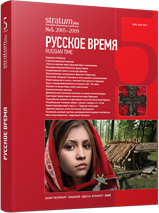Дома с сенями на юго-востоке Руси
Houses with Porch (seni) in South-Eastern Rus’
Author(s): Vladimir V. Enukov, Olga N. EnukovaSubject(s): History, Archaeology, Middle Ages, 6th to 12th Centuries
Published by: Издательский дом Stratum, Университет «Высшая антропологическая школа»
Keywords: Houses with Porch; South-Eastern Rus’; Romensk population; Severska’ya land; Kursk volost; Novgorod; Kiev
Summary/Abstract: Deepened felling houses with an oven in the corner were typical for the Romensk population of the Severska’ya land, at the same time the walls of the houses were placed at some distance from a foundation pit. As a result benches appeared on the sides of the placement, later on they were typical for the Slavonic-Russian habitation right up to the newest period of history. Habitations which have left rectangular foundation pits are also dating to the Old Russian time. The aim of this work was finding the answer to the question whether this similarity has genetic bond, or not. Analysis of the house building materials has been undertaken in one of the most densely populated region of the South-West Russia – the Kursk volost (princedom).There are only six well-known buildings with dwelling foundation pits dating to the Old Russian time. Other structural schemes have obtained wider distribution, there are two leading ones among them: ground-based felling houses with cellar hole adjoining an oven, and double deck felling houses in which the living quarters were situated on the cold podklet of the household purpose. Four of six houses with dwelling foundation pits have been found out at the settlement 1 in Lipino and one in villages of Moisseevo and Lyushinka each. It turned out that all of them had inner porch, at that the leading construction was a whole-log two-chamber five-wall house. The special setting of the space in front of the entrance wasn’t well-known at the Romensk time. Similar constructions but without deepened quarters were well-known in Novgorod and Kiev, they became common at the end of the 10th –11th centuries in these areas. Appearance of inner porch at one time in the house building of the population of the Kursk volost is explained by the all-Russian influence. One can suppose that such houses mainly belonged to free population, though this relation was hardly of strong character.The small number of buildings of this type, in which the traditions of the preceding period are traceable, is the evidence of the marked changes in the house building in the region.
Journal: Stratum plus. Археология и культурная антропология
- Issue Year: 2009
- Issue No: 5
- Page Range: 41-57
- Page Count: 17
- Language: Russian
- Content File-PDF

